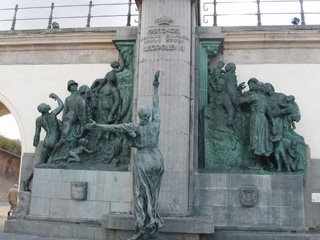 |
| Figure 1: A glimpse into the romantic city of Bruges. |
Today, we took a day trip to Bruges, the most romantic and
beautiful city of the Low Countries. Turns out, if any tourist would come to
the Low Countries, they would only see Bruges and nowhere else because it is a
city that’s stuck in history. Ever since the Middle Ages, the government gave
money to the “more important cities”, such as Antwerp and Brussels, so that
they could advance and move on, but Bruges just stayed the way it was, as a
city in the middle ages. So tourists come to Bruges to experience the middle
ages and the romantic city it is. In the middle ages, the population of the
city was double its current population, which implies how Bruges was once an
important city in Flanders.
 |
| Figure 2: An ancient document of the archive. |
Our first stop in Bruge was the city archive, where the
director, Noel Geernaert, showed us some of the huge collection of documents
that record the city’s administration and history. One of the documents even
recorded this religious creed that was given to Bruges. Another document had
all the laws that were applied to the city of Brugeduring the time of the
Flemish movement. It was interesting to see how some of the documents were of
animal skin, wood, and then paper. Seeing the progression of material for these
documents showed me how civilization advanced throughout the ages. Printing
techniques were also invented as time passed, allowing some documents to be
printed by machines instead of by hand. Although printing techniques may have
allowed people to produce documents in an efficient manner, some documents were
not as legible as others, so some ancient documents were more legible than
later documents.
Afterwards, we were given a tour of the city and visited the
City hall and the Chapel of the Holy Blood. I was astounded when I heard people
could pay to see the “Holy Blood”. I was talking to a classmate, and she and I
both concluded that we thought it was fake blood being displayed for commercial
purposes. Scientifically speaking, blood is bright red when oxygen is still
present in the blood. The moment blood leaves the body, the oxygen will escape
from the blood too, which is why blood does not stay bright red for long.
Logically speaking, do you really think the blood displayed at that church is
the blood from 2,000 years ago when Christ died? I don’t think people back in
the day had the technology or science to preserve oxygen in blood so that it
would last into the 21th century for people to see. I find it amusing how
people use the name of the church or other religious objects to raise money.
Other than that, I was able to sense the religious atmosphere of the church
since the church had so many images of Christ nailed to the cross and religious
sounding music playing in the background. The atmosphere certainly rouses up
anyone’s emotions to feel the religious atmosphere. I do appreciate how people
respected the rules of the church, and it was interesting to see how some
believers were mesmerized by the statues and images of Christ on the cross. If
only they knew exactly how to contact the Lord what the Lord desires…
 |
| Figure 3: The Last Supper by Sustave van de Woestyne |
Lastly, we visited the Groeninge Museum, which has
collections of Flemish medical masters, including Jan van Eyck and Hieronymus
Bosch. I was impressed by the “Last Supper” by Sustave van de Woestyne in 1927.
It was this huge painting telling the story of The Last Supper in the style of
Flemish Expressionism. The facial expressions of the men were a little distorted;
I couldn’t make out how the artist thought the men felt during the last supper.
I observed how there were many thick and spontaneous brushstrokes, which is
very much the style of Flemish Expressionism. This piece of art was perhaps the
largest piece of the museum, catching most people’s attention. Because the
artist chose this piece to be gigantic, I’ll assume he holds the Last Supper as
a very important event in history.










